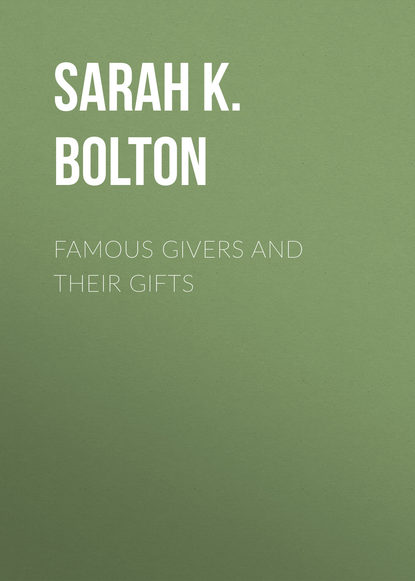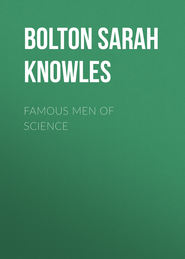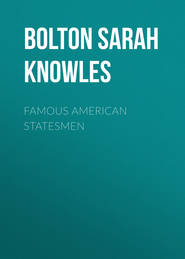По всем вопросам обращайтесь на: info@litportal.ru
(©) 2003-2024.
✖
Famous Givers and Their Gifts
Настройки чтения
Размер шрифта
Высота строк
Поля
AND HIS ART GALLERY
William Wilson Corcoran was born Dec. 27, 1798, at Georgetown, D.C. He was the son of Thomas Corcoran, who settled in Georgetown when a youth, and became one of its leading citizens. He was mayor, postmaster, and one of the founders of the Columbian College, of which institution he was an active trustee while he lived. He was also one of the principal founders of two Episcopal churches in Georgetown, St. John's and Christ's Church, and was always a vestryman in one or the other.
His son William, after a good preparatory education, spent a year at the Georgetown College, and a year at the school of the Rev. Addison Belt, a graduate of Princeton. His father desired that he should complete his college course; but William was eager to enter upon a business life, and when he was seventeen went into the dry-goods store of his brothers, James and Thomas Corcoran. Two years later they established him in business under the firm name of W. W. Corcoran & Co. The firm prospered so well that the wholesale auction and commission business was begun in 1819.
For four years the firm made money; but in the spring of 1823, they, with many other merchants in Georgetown and Baltimore, failed, and were obliged to settle with their creditors for fifty cents on the dollar.
Young Corcoran, then twenty-five years of age, devoted himself to caring for the property of his father, who was growing old. The father died Jan. 27, 1830. Five years later, in 1835, Mr. Corcoran married Louise A. Morris, who lived but five years after their marriage, dying Nov. 21, 1840, leaving a son and daughter. The son died soon after the death of his mother; the daughter grew to womanhood, and became a great joy to her father. She married the Hon. George Eustis, a member of Congress from Louisiana, and died in early life at Cannes, France, 1867, leaving three small children.
Mr. Corcoran long before this had become a very successful banker. Two years after his marriage, in 1837, he moved his family to Washington, and began the brokerage business in a small store, ten by sixteen feet, on Pennsylvania Avenue near Fifteenth Street. After three years he took into partnership Mr. George W. Riggs, the son of a wealthy man from Maryland, under the firm name of Corcoran & Riggs.
In 1845 they purchased the old United States Bank building, corner of Fifteenth Street and New York Avenue; and two years later Mr. Corcoran settled with his creditors of 1823, paying principal and interest, about $46,000. During the Mexican war the firm made extensive loans to the government, which conservative bankers regarded as a hazardous investment. Mr. Riggs retired from the firm July 1, 1848; and his younger brother, Elisha, was made a junior partner.
"In August, 1848, having about twelve millions of the six-per-cent loan of 1848 on hand, and the demand for it falling off in this country, and the stock being one per cent below the price at which Corcoran & Riggs took it, Mr. Corcoran determined to try the European markets; and, after one day's reflection, embarked for London, where, on arrival, he was told by Mr. Bates, of the house of Baring Bros. & Co., and Mr. George Peabody, that no sale could be made of the stock, and no money could be raised by hypothecation thereof, and they regretted that he had not written to them to inquire before coming over. He replied that he was perfectly satisfied that such would be their views, and therefore came, confident that he could convince them of the expediency of taking an interest in the securities; and that the very fact that London bankers had taken them would make it successful.
"Ten days after his first interview with them, Mr. Thomas Baring returned from the Continent, and with him he was more successful. A sale of five millions at about cost (one hundred and one here) was made to six of the most eminent and wealthy houses in London, viz., Baring Bros. & Co., George Peabody, Overend, Gurney & Co., Dennison & Co., Samuel Jones Lloyd, and James Morrison.
"This was the first sale of American securities made in Europe since 1837; and on his return to New York he was greeted by every one with marked expressions of satisfaction, his success being a great relief to the money market by securing that amount of exchange in favor of the United States. On his success being announced, the stock gradually advanced until it reached one hundred and nineteen and one-half, thus securing by his prompt and successful action a handsome profit which would otherwise have resulted in a serious loss."
On April 1, 1854, Mr. Corcoran withdrew from the banking-firm, and devoted himself to the management of his property and to his benevolent projects.
In 1859 he began, at the northeast corner of Pennsylvania Avenue and Seventeenth Street, a building for the encouragement of the Fine Arts. The structure was used during the Civil War for military purposes. In 1869 Mr. Corcoran deeded this property to trustees. "I shall ask you to receive," he wrote the trustees, "as a nucleus, my own gallery of art, which has been collected at no inconsiderable pains; and I have assurances from friends in other cities, whose tastes and liberality have taken this direction, that they will contribute fine works of art from their respective collections… I venture to hope that with your kind co-operation and judicious management we shall have provided, at no distant day, not only a pure and refined pleasure for residents and visitors of the national metropolis, but have accomplished something useful in the development of American genius."
In 1869 Mr. Corcoran also deeded to trustees the Louise Home, erected in memory of his wife and daughter, as a home for refined and educated gentlewomen who had "become reduced by misfortune."
The deed specified that "there shall be no discrimination or distinction on account of religious creed or sectarian opinions, in respect to the trustees, directresses, officers, or inmates of the said establishment; but all proper facilities that may be possible in the judgment of the trustees shall be allowed and furnished to the inmates for the worship of Almighty God, according to each one's conscientious belief."
The building and grounds of the Louise Home in 1869 were estimated at $200,000, and are now worth probably over $500,000. The endowment consisted of an invested fund of $325,000.
Mr. Corcoran gave generously as long as he lived, having decided early in life that "at least one-half of his moneyed accumulations should be held for the welfare of men."
In Oak Hill Cemetery he erected a beautiful monument to the memory of John Howard Payne, author of "Home, Sweet Home." It is a shaft of Carrara marble, surmounted by a bust one and one-half times the size of the average man.
In his old age he purchased the Patapsco Institute at Ellicott's Mills, and gave the title-deeds to the two grand-nieces of John Randolph of Roanoke, who were in reduced circumstances, that they might open a school.
He gave to Columbian University, it is stated, houses and lands and money, amounting to a quarter of a million dollars. The University of Virginia, the Ascension Church, and other colleges and churches, were enriched through his generosity.
Mr. Corcoran died in Washington, Feb. 24, 1888, at the age of ninety years. He had given away over five million dollars.
"The treasures of the Corcoran Art Gallery," said its president in laying the corner-stone of a new building two years ago, "represent a money cost of $346,938 (exclusive of donations), a cost value which, of course, is greatly below the real value which these treasures represent to-day. The total value of the gallery, in its treasures, its endowments, and its buildings, is estimated to-day at $1,926,938. The total number of visitors who have inspected the paintings and sculpture exhibited in the gallery from the date of its opening down to the beginning of this month [May, 1896] was 1,696,489."
JOHN D. ROCKEFELLER
AND CHICAGO UNIVERSITY
From our windows we look out upon a forest of beautiful beech-trees, great oaks, and maples. There are well-kept drives, cool ravines with tasteful walks, a pretty lake and boat-house, and great stretches of lawn, in the four hundred or more acres, such as one sees in England. The gravelled roadways are appropriately named. "Blithedale" leads into a charming valley, through which a brook winds in and out, under a dozen bridges. The "Maze" leads through clusters of beeches and other undergrowth, and opens upon a magnificent view of blue Lake Erie at the right and the busy city at the left. In the distance, on a hilltop, stands a large white frame house, with red roof. Vines clamber over the broad double porches, red trumpet-creepers twine and blossom about some of the big oaks, beds of roses send out their fragrance, and the place looks most attractive and restful.
It is "Forest Hill," at Cleveland, Ohio, the summer home of Mr. John D. Rockefeller, probably the greatest giver in America. Our largest giver heretofore, so far as known, was George Peabody, who gave at his death $9,000,000. Mr. Rockefeller has given about $7,500,000 to one institution, besides several hundred thousand dollars each year for the past twenty-five years to various charities.
Mr. Rockefeller comes from very honorable ancestry. The Rockefellers were an old French family in Normandy, who moved to Holland, and came to America about 1650, settling in New Jersey. Nearly a century ago, in 1803, Mr. Rockefeller's grandfather, Godfrey, married Lucy, one of the Averys of Groton, Conn., a family distinguished in the Revolutionary War, and which has since furnished to our country many able men and women.
The picturesque home of the Averys, built in 1656, in the town of New London (now Groton), by Captain James Avery, was occupied by his descendants until it was destroyed by fire in 1894. A monument has been erected upon the site, with a bronze tablet containing a fac-simile of the old home.
The youngest son of Captain James Avery was Samuel, whose fine face looks out from the pages of the interesting Avery Genealogy, which Homer D. L. Sweet, of Syracuse, spent thirty years in writing. Samuel, an able and public-spirited man, married, in 1686, in Swanzey, Mass., Susannah Palmes, a direct descendant, through thirty-four generations, of Egbert, the first king of England. The name has always been retained in the family, Lucy Avery Rockefeller naming her youngest son Egbert. Her eldest son, William Avery, married Eliza Davison; and of their six children, John Davison Rockefeller is the second child and eldest son.
He was born in Richford, Tioga County, N.Y., July 8, 1839. His father, William Avery, was a physician and business man as well. With great energy he cleared the forest, built a sawmill, loaned his money, and, like his noted son, knew how to overcome obstacles.
The mother, Eliza Davison, was a woman of rare common sense and executive ability. Self-poised in manner, charitable, persevering in whatever she attempted, she gave careful attention to the needs of her family, but did not forget that she had Christian duties outside her home. The devotion of Mr. Rockefeller to his mother as long as she lived was marked, and worthy of example.
The Rockefeller home in Richford was one of mutual work and helpfulness. The eldest child, Lucy, now dead, was less than two years older than John; the third child, William, about two years younger; Mary, Franklin and Frances, twins, each about two years younger than the others; the last named died early. All were taught the value of labor and of economy.
The eldest son, John, early took responsibility upon himself. Willing and glad to work, he cared for the garden, milked the cows, and acquired the valuable habit of never wasting his time. When about nine years old he raised and sold turkeys, and instead of spending the money, probably his first earnings, saved it, and loaned it at seven per cent. It would be interesting to know if the lad ever dreamed then of being perhaps the richest man in America?
In 1853 the Rockefeller family moved to Cleveland, Ohio; and John, then fourteen years of age, entered the high school. He was a studious boy, especially fond of mathematics and of music, and learned to play on the piano; he was retiring in manner, and exemplary in conduct. When between fourteen and fifteen years of age, he joined the Erie Street Baptist Church of Cleveland, Ohio, now known as the Euclid Avenue Baptist Church, where he has been from that time an earnest and most helpful worker in it. The boy of fifteen did not confine his work in the church to prayer-meetings and Sunday-school. There was a church debt, and it had to be paid. He began to solicit money, standing in the church-door as the people went out, ready to receive what each was willing to contribute. He gave also of his own as much as was possible; thus learning early in life, not only to be generous, but to incite others to generosity.
When about eighteen or nineteen, he was made one of the Board of Trustees of the church, which position he held till his absence from the city in the past few years prevented his serving. He has been the superintendent of the Sunday-school of the Euclid Avenue Baptist Church for about thirty years. When he had held the office for twenty-five years the Sunday-school celebrated the event by a reception for their leader. After addresses and music, each one of the five hundred or more persons present shook hands with Mr. Rockefeller, and laid a flower on the table beside him. From the first he has won the love of the children from his sympathy, kindness, and his interest in their welfare. No picnic even would be satisfactory to them without his presence.
After two years passed in the Cleveland High School, the school-year ending June, 1855, young Rockefeller took a summer course in the Commercial College, and at sixteen was ready to see what obstacles the business world presented to a boy. He found plenty of them. It was the old story of every place seeming to be full; but he would not allow himself to be discouraged by continued refusals. He visited manufacturing establishments, stores, and shops, again and again, determined to find a position.
He succeeded on the twenty-sixth day of September, 1855, and became assistant bookkeeper in the forwarding and commission house of Hewitt & Tuttle. He did not know what pay he was to receive; but he knew he had taken the first step towards success, – he had obtained work. At the end of the year, for the three months, October, November, and December, he received fifty dollars, – not quite four dollars a week.
The next year he was paid twenty-five dollars a month, or three hundred dollars a year, and at the end of fifteen months, took the vacant position with the same firm, at five hundred dollars, as cashier and bookkeeper, of a man who had been receiving a salary of two thousand dollars.
Desirous of earning more, young Rockefeller after a time asked for eight hundred dollars as wages; and, the firm declining to give over seven hundred dollars a year, the enterprising youth, not yet nineteen, decided to start in business for himself. He had industry and energy; he was saving of both time and money; he had faith in his ability to succeed, and the courage to try. He had managed to save about a thousand dollars; and his father loaned him another thousand, on which he paid ten per cent interest, receiving the principal as a gift when he became twenty-one years of age. This certainly was a modest beginning for one of the founders of the Standard Oil Company.
Having formed a partnership with Morris B. Clark, in 1858, in produce commission and forwarding, the firm name became Clark & Rockefeller. The closest attention was given to business. Mr. Rockefeller lived within his means, and worked early and late, finding little or no time for recreation or amusements, but always time for his accustomed work in the church. There was always some person in sickness or sorrow to be visited, some child to be brought into the Sunday-school, or some stranger to be invited to the prayer-meetings.
The firm succeeded in business, and was continued with various partners for seven years, until the spring of 1865. During this time some parts of the country, especially Pennsylvania and Ohio, had become enthusiastic over the finding of large quantities of oil through drilling wells. The Petroleum Age for December, 1881, gives a most interesting account of the first oil-well in this country, drilled at Titusville, on Oil Creek, a branch of the Alleghany River, in August, 1859.
Petroleum had long been known, both in Europe and America, under various names. The Indians used it as a medicine, mixed it with paint to anoint themselves for war, or set fire at night to the oil that floated upon the surface of their creeks, making the illumination a part of their religious ceremonies. In Ohio, in 1819, when, in boring for salt, springs of petroleum were found, Professor Hildreth of Marietta wrote that the oil was used in lamps in workshops, and believed it would be "a valuable article for lighting the street-lamps in the future cities of Ohio." But forty years went by before the first oil-well was drilled, when men became almost as excited as in the rush to California for gold in 1849.
Several refineries were started in Cleveland to prepare the crude oil for illuminating purposes. Mr. Rockefeller, the young commission merchant, like his father a keen observer of men and things, as early as 1860, the year after the first well was drilled, helped to establish an oil-refining business under the firm name of Andrews, Clark, & Co.
The business increased so rapidly that Mr. Rockefeller sold his interest in the commission house in 1865, and with Mr. Samuel Andrews bought out their associates in the refining business, and established the firm of Rockefeller & Andrews, the latter having charge of the practical details.
Mr. Rockefeller was then less than twenty-six years old; but an exceptional opportunity had presented itself, and a young man of exceptional ability was ready for the opportunity. A good and cheap illuminator was a world-wide necessity; and it required brain, and system, and rare business ability to produce the best product, and send it to all nations.
The brother of Mr. Rockefeller, William, entered into the partnership; and a new firm was established, under the name of William Rockefeller & Co. The necessity of a business house in New York for the sale of their products soon became apparent, and all parties were united in the firm of Rockefeller & Co.
In 1867 Mr. Henry M. Flagler, well known in connection with his improvements in St. Augustine, Fla., was taken into the company, which became Rockefeller, Andrews, & Flagler. Three years later, in 1870, the Standard Oil Company of Ohio was established with a capital of $1,000,000, Mr. Rockefeller being made president. He was also made president of the National Refiners' Association.
He was now thirty-one years old, far-seeing, self-centred, quiet and calm in manner, but untiring in work, and comprehensive in his grasp of business. The determination which had won a position for him in youth, even though it brought him but four dollars a week, the confidence in his ability, integrity, and sound judgment, which made the banks willing to lend him money, or men willing to invest their capital in his enterprise, made him a power in the business world thus early in life.
Amid all his business and his church work, he had found time to form another partnership, the wisest and best of all. In the same high school with him for two years was a young girl near his own age, Laura C. Spelman, a bright scholar, refined and sensible.
Her father was a merchant, a Representative in the Legislature of Ohio, an earnest helper in the church, in temperance, and in all that lifts the world upward. He was the friend of the slave; and the Spelman home was one of the restful stations on that "underground railroad" to which so many colored men and women owe their freedom. He was an active member for years of Plymouth Congregational Church in Cleveland, and later of Dr. Buddington's church in Brooklyn, and of the Broadway Tabernacle, New York, under Dr. Wm. M. Taylor. He died in New York City, Oct. 10, 1881.
Mrs. Spelman, the mother, was also a devoted Christian. She now lives, at the age of eighty-six, with her daughter, grateful, as she says, for life's beautiful sunset. She is loved by everybody, and her sweet face and voice would be sadly missed. She retains all her faculties, and has as deep an interest as ever in all religious, philanthropic, and political affairs.










